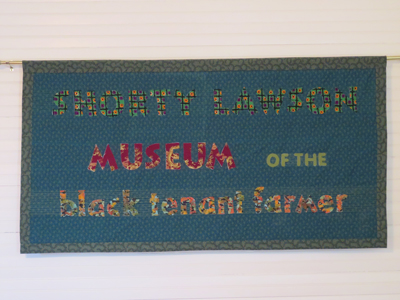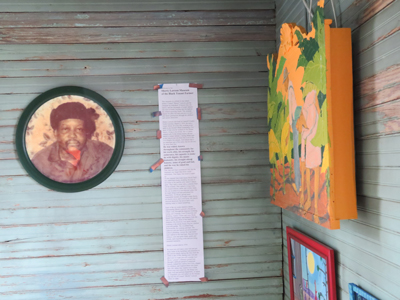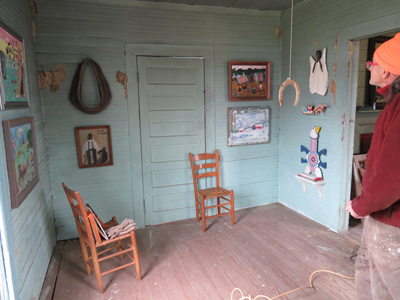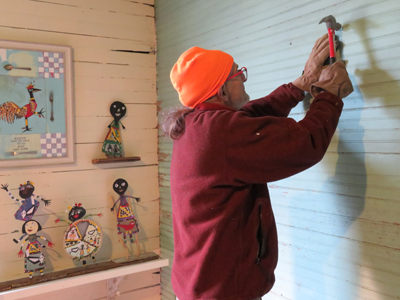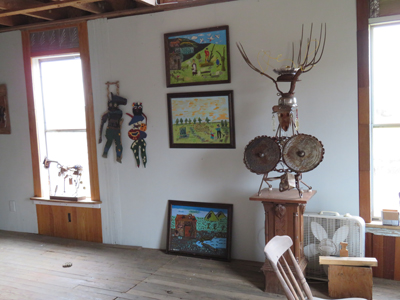
| |
Of all these, the landscapes of Hesters Store, North Carolina, are most special. They shaped me just as I shaped them. They forged my identity and taught me how to design. In fact, they taught me almost everything I know, most of what I have taught others, and everything that I contributed to Inhabiting the Sacred in Everyday Life. There is the homeplace that my grandson, Atticus, told me loved him. There is Kurama where he asked why God created such an arrangement of rocks. There is cropland where Daddy expected me to endure the pain of repetitive labor and learn to thrive on it; his watermelon patch where he initiated Marcia to more than a single slice, all heart; the east-facing slope where Mother introduced me to wildflowers; the deer stand my son, Nate, and his wife, Saralynn, gave me where I paint sliver moons reflected in still water; Sofa Rock on Knotty Creek where wood ducks share the secret to life with me and suggest that I sit still if I am pursuing wisdom. I love these places, and they love my family and me in return. The land at Hester's store has been farmed by Hesters since before the Revolutionary War. My grandson is the tenth generation. The place provides security and reciprocates caring. North Carolina was the poor man's paradise, and the place fulfilled the Hesters. By my dad's generation, the land had been gifted to so many descendants that his parents' small farm couldn't sustain our family. We were landless. We day labored in tobacco so Daddy could buy back the land he grew up on. The landscape transferred his value of land stewardship to me. He is dead, but the land continues to convey his values. The cultivated land we cut from the oak-hickory forest embodied the need to attend the most nuanced grading and drainage for soil conservation. Each field held special meaning. One embodies Shorty Lawson, the black sharecropper with whom I cropped tobacco my entire youth. That field sloping down to Hyco Creek contains his spirit and a brotherhood beyond the color of skin. I learned the colors of skin and humanity from Shorty Lawson. During the past four years I have created a "museum" as a tribute to Cornell "Shorty" Lawson. It was and is a most special place for me. Lawson was born in Caswell County, North Carolina, on March 5 1938. He was a tenant farmer all of his life. For most of that time he lived in the house on the Tom Bowes Farm that I am making into the museum. He was widely known throughout the community for his honesty, his sense of good and bad, his work ethic, his strength, his endurance, his capacity to make dignified things from scrap, his manly humanity, and the way he raised his children. Race constrained his fortune, but he did not let racism define him. Because I worked with him every day during the most formative period of my life, he taught me more about farming, hard work, race and class, caring and enduring values than anyone else. He dispelled every racial stereotype of our time. He was the single hardest-working man I have ever known. When we pulled tobacco, he worked two rows. I worked one, and he always met me coming back, helping me with my single row. He died in 1974. After Shorty died, his house fell into disrepair. The oak sill rotted; the south wall collapsed into the overgrown yard. I didn't want his memory erased, so I started repairing the house with discarded materials I found on the farm. That was how Shorty had once improved the place. I had no expectation to do anything more. But a neighbor stopped by and asked why I was working on that old tenant house, and, without thinking, I responded, "I'm making a museum for Shorty." That crystallized my subconscious intention. Shorty's daughter, Carolyn, and I started meeting to share stories about her father. Family and neighbors offered memories of him. A film maker undertook a documentary. I mapped the family's sacred places and drew house and site plans to reconstruct lost places. I content analyzed all the stories from which grew a concept: Each room illustrates the daily life of Shorty's family from about 1950 until his death. But instead of furnishing each space as a history museum, we use outsider art, combined with the text we wrote, to explain Shorty's remarkable character. To history he was just another tenant farmer, but his story should not be forgotten. He lived by the seasons, so one room tells of family life in summer (tobacco, illustrated with a painting of worming rows of the cash crop), fall (selling, buying, and repairing, illustrated by an old mule collar Shorty patched), winter (hog killing, shown in a painting by memory artist Bernice Sims), and spring (plowing, planting, and mating, depicted in a tin cutout "Mr. Rooster Tending the Chicks after His Wife Left Him" by outsider artist Buddy Snipes). Other rooms focus on food production, family values and fishing, work and prejudice, snakes, God, and the Devil. I left most of the rooms painted "Haint Blue" or repainted them that special electric hue to keep ghosts away. Shorty had added two rooms as he had more expendable income, so I painted those rooms gallery white to better display the art depicting tenant farming. The art is primarily done by untrained African-American artists who created folk, visionary, or resistance works during the Jim Crow era up to the present. Many of these artists had been Southern tenant farmers themselves, so their paintings capture the detail and passion of Shorty's life. Works by Willie Jinks, Mama Johnson, Thorton Dial, Mose Tolliver, Mary T. Smith, and Purvis Young express the essence of chores and emotions the Lawsons experienced. They make you sweat in July's heat, delight when a big fish hits your hook, and fly back to Africa on the wings of an owl to escape slavery. Eula Parris's paintings show not only harsh everyday life, but also how the landscape itself felt. Benny Grinstead carved mules at work that are more like mules at work than mules at work. Charlie Lucas created the touching Lawson family portrait as a present for the museum; Joe Minter gifted a magnificent African Queen. Shorty's wife, Annie, and their older daughter, Carolyn, cooked on both a wood stove and an electric one. They had electricity but no well. Water had to be fetched from the Big House across the Tom Bowes Road. Shorty's invention to collect rain water to wash clothes is shown in a Wringer washer, and the bucket to wash hair is depicted in a painting by Black Joe Jackson as both extreme hardship and creative solution. Many of the family's most cherished places were outside the house. In recent months I have rebuilt the woodshed, smokehouse, outhouse and basketball goal, repaired tobacco barns, laid out garden, clothes line, hog lot, and chicken coop. Today my cousins, five and eight years old, visited the museum for the first time. They studied Shorty's portrait as their grandfather described him, but mostly they touched things as if the art was speaking to them not by sight but by more intimate senses. Caroline's favorite thing was a jet plane by O. L. Samuels illustrating how Shorty transitioned from a one-mule economy to machinery more powerful than his extraordinary strength. Anniston wanted to know why the African Queen was bound by chains and locks. We talked about slavery. She also asked why there were four chairs, two black and two white, one fine and the others worn or worse, in a circle, but the answer was interrupted by her sister's delight in a sculpted mule with a tail made from bells that Caroline was ringing. They wanted to know how you flushed the toilet in the outhouse and were amazed that one pooped into a hole in the ground. They offered keen observations like "This house is small" and asked penetrating questions about race that the museum will answer in time. I could feel their young compassion for Shorty's family. They seemed to know that this was a special domain. This project is a labor of love. It is a special place, yes, even sacred, to me. I hope it will move visitors to joy and tears, spur thoughtfulness about things that matter, impel others to cross boundaries of all sorts, and stimulate creative, even unconventional radical action. This "museum" now has a new life of its own that could not have emerged in this form under any other cultural, environmental, and personal circumstances. I work on it most days. Today I repaired the foundation. No one would hire me to do concrete patch work, but I managed to close holes that were letting cold air chill the house. I finished the job just in time to warm the spirit of Cornell Lawson and his family as the wind chill dropped to twelve degrees. I imagined that he invited me in to sit by the kitchen fire. Copyright © 2019 Randy Hester. All rights reserved.
|
